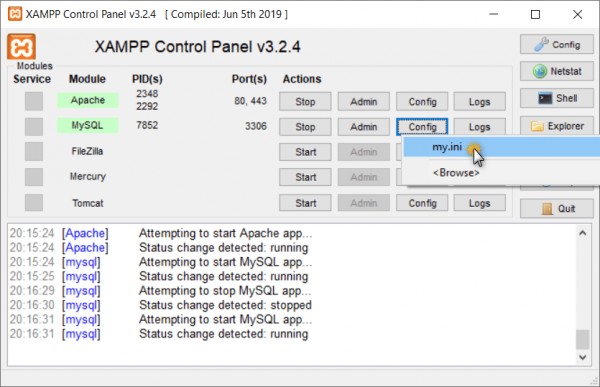SQL Injection is best prevented through the use of parameterized queries. The following chart demonstrates, with real-world code samples, how to build parameterized queries in most of the common web languages. The purpose of these code samples is to demonstrate to the web developer how to avoid SQL Injection when building database queries within a web application
Prepared Statement Examples
| Language – Library | Parameterized Query |
|---|---|
| Java – Standard |
String custname = request.getParameter("customerName");
String query = "SELECT account_balance FROM user_data WHERE user_name = ? ";
PreparedStatement pstmt = connection.prepareStatement( query );
pstmt.setString( 1, custname);
ResultSet results = pstmt.executeQuery( );
|
| Java – Hibernate |
//HQL
@Entity // declare as entity;
@NamedQuery(
name="findByDescription",
query="FROM Inventory i WHERE i.productDescription = :productDescription"
)
public class Inventory implements Serializable {
@Id
private long id;
private String productDescription;
}
// use case
String userSuppliedParameter = request.getParameter("Product-Description"); // This should REALLY be validated too
// perform input validation to detect attacks
List<Inventory> list =
session.getNamedQuery("findByDescription")
.setParameter("productDescription", userSuppliedParameter).list();
//Criteria API
String userSuppliedParameter = request.getParameter("Product-Description"); // This should REALLY be validated too
// perform input validation to detect attacks
Inventory inv = (Inventory) session.createCriteria(Inventory.class).add
(Restrictions.eq("productDescription", userSuppliedParameter)).uniqueResult();
|
| .NET/C# |
string sql = "SELECT * FROM Customers WHERE CustomerId = @CustomerId";
SqlCommand command = new SqlCommand(sql);
command.Parameters.Add(new SqlParameter("@CustomerId", System.Data.SqlDbType.Int));
command.Parameters["@CustomerId"].Value = 1;
|
| ASP.NET |
String query = "SELECT account_balance FROM user_data WHERE user_name = ?";
try {
OleDbCommand command = new OleDbCommand(query, connection);
command.Parameters.Add(new OleDbParameter("customerName", CustomerName Name.Text));
OleDbDataReader reader = command.ExecuteReader();
// …
} catch (OleDbException se) {
// error handling
}
|
| Ruby – ActiveRecord |
# Create
Project.create!(:name => 'owasp')
# Read
Project.all(:conditions => "name = ?", name)
Project.all(:conditions => { :name => name })
Project.where("name = :name", :name => name)
# Update
project.update_attributes(:name => 'owasp')
# Delete
Project.delete(:name => 'name')
|
| Ruby |
insert_new_user = db.prepare "INSERT INTO users (name, age, gender) VALUES (?, ? ,?)" insert_new_user.execute 'aizatto', '20', 'male' |
| PHP – PDO |
$stmt = $dbh->prepare("INSERT INTO REGISTRY (name, value) VALUES (:name, :value)");
$stmt->bindParam(':name', $name);
$stmt->bindParam(':value', $value);
|
| Cold Fusion |
<cfquery name = "getFirst" dataSource = "cfsnippets">
SELECT * FROM #strDatabasePrefix#_courses WHERE intCourseID =
<cfqueryparam value = #intCourseID# CFSQLType = "CF_SQL_INTEGER">
</cfquery>
|
| Perl – DBI |
my $sql = "INSERT INTO foo (bar, baz) VALUES ( ?, ? )"; my $sth = $dbh->prepare( $sql ); $sth->execute( $bar, $baz ); |
Stored Procedure Examples
The SQL you write in your web application isn’t the only place that SQL injection vulnerabilities can be introduced. If you are using Stored Procedures, and you are dynamically constructing SQL inside them, you can also introduce SQL injection vulnerabilities. To ensure this dynamic SQL is secure, you can parameterize this dynamic SQL too using bind variables. Here are some examples of using bind variables in stored procedures in different databases:
| Language – Library | Parameterized Query |
|---|---|
| Oracle – PL/SQL | Normal Stored Procedure – no dynamic SQL being created. Parameters passed in to stored procedures are naturally bound to their location within the query without anything special being required.
PROCEDURE SafeGetBalanceQuery( UserID varchar, Dept varchar) AS BEGIN SELECT balance FROM accounts_table WHERE user_ID = UserID AND department = Dept; END; |
| Oracle – PL/SQL | Stored Procedure Using Bind Variables in SQL Run with EXECUTE. Bind variables are used to tell the database that the inputs to this dynamic SQL are ‘data’ and not possibly code.
PROCEDURE AnotherSafeGetBalanceQuery(
UserID varchar, Dept varchar) AS
stmt VARCHAR(400); result NUMBER;
BEGIN
stmt := 'SELECT balance FROM accounts_table WHERE user_ID = :1
AND department = :2';
EXECUTE IMMEDIATE stmt INTO result USING UserID, Dept;
RETURN result;
END;
|
| SQL Server- Transact-SQL | Normal Stored Procedure – no dynamic SQL being created. Parameters passed in to stored procedures are naturally bound to their location within the query without anything special being required.
PROCEDURE SafeGetBalanceQuery( @UserID varchar(20), @Dept varchar(10)) AS BEGIN SELECT balance FROM accounts_table WHERE user_ID = @UserID AND department = @Dept END |
| SQL Server- Transact-SQL | Stored Procedure Using Bind Variables in SQL Run with EXEC. Bind variables are used to tell the database that the inputs to this dynamic SQL are ‘data’ and not possibly code.
PROCEDURE SafeGetBalanceQuery(@UserID varchar(20),
@Dept varchar(10)) AS BEGIN
DECLARE @sql VARCHAR(200)
SELECT @sql = 'SELECT balance FROM accounts_table WHERE '
+ 'user_ID = @UID AND department = @DPT'
EXEC sp_executesql @sql,
'@UID VARCHAR(20), @DPT VARCHAR(10)',
@UID=@UserID, @DPT=@Dept
END
|





























